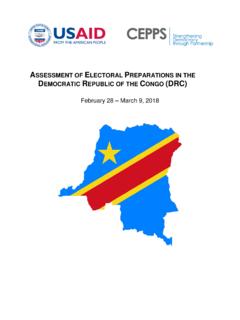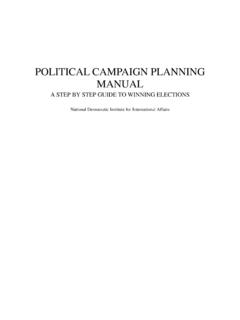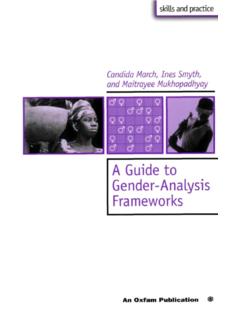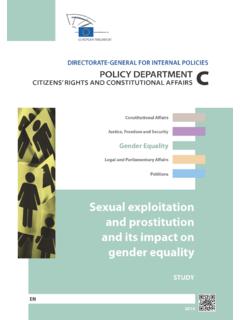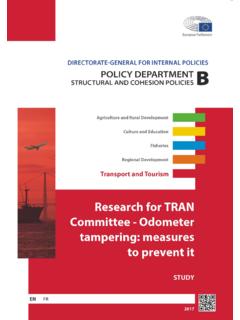Transcription of DIRECTORATE GENERAL FOR INTERNAL POLICIES
1 DIRECTORATE GENERAL FOR INTERNAL POLICIES POLICY DEPARTMENT C: CITIZENS' RIGHTS AND CONSTITUTIONAL AFFAIRES GENDER EQUALITY Electoral Gender Quota Systems and their implementation in Europe STUDY Abstract The report maps the diffusion of electoral gender quotas in the 30 EU/EEA countries. In 21 of the countries some type of gender quotas are in use, either legislated or voluntary party quotas. The report evaluates the effectiveness of different quota types in different electoral systems. Some gender quotas have resulted in major leaps in women s representation, while others had led to almost no change.
2 The conclusion is that in order to be effective in changing women s historical under-representation electoral gender quotas have to fit the electoral system and should include regulations about the rank order of women and men on the electoral lists as well as sanctions for non-compliance. In GENERAL , the report reveals a mixed picture in Europe when it comes to women s representation. This up-dated version of the 2008-study (PE ) shows that women s parliamentary representation increased only from % in 2008 to in 2011.
3 In the most recent parliamentary election in 13 of the countries as well as in the election to the European Parliament women s representation increased, but ten countries experienced stagnation and in seven for the countries women s share of the MPs dropped. Eight case studies on Belgium, France, Germany, Poland, Slovenia, Spain, Sweden and the United Kingdom are included in the report. PE EN This document was requested by the European Parliament's Committee on Gender Equality. AUTHORS Drude Dahlerup, professor and Lenita Freidenvall, associate professor with the assistance of Emil Johansson, Eleonora Stolt, Katarina Bivald and Lene Persson-Weiss, WIP, Women in Politics Research Centre, Department of Political Science, Stockholm University, Eight case study authors.
4 RESPONSIBLE ADMINISTRATOR Claire GENTA Policy Department C: Citizens' Rights and Constitutional Affairs European Parliament B-1047 Bruxelles E-mail: LINGUISTIC VERSIONS Original: EN ABOUT THE EDITOR To contact the Policy Department or to subscribe to its newsletter please write to: Manuscript completed in September 2011. Brussels, European Parliament, 2011. This document is available on the Internet at: DISCLAIMER The opinions expressed in this document are the sole responsibility of the author and do not necessarily represent the official position of the European Parliament.
5 Reproduction and translation for non-commercial purposes are authorized, provided the source is acknowledged and the publisher is given prior notice and sent a copy. Electoral Gender Quota Systems and their Implementation in Europe 3 CONTENTS TABLES AND FIGURES 8 EXECUTIVE SUMMARY 10 SECTION A: MAPPING AND CROSS-COUNTRY/ CROSS-PARTY ANALYSES 12 1. MAPPING OF ELECTORAL GENDER QUOTAS: FREQUENCY AND TYPES 12 International recommandations 13 Constitutional reform and rejection 15 Mapping the use of gender quotas 16 Types of gender quotas 21 Two dimensions of quota systems 21 Quotas for women or gender-neutral quotas?
6 23 Electoral systems and quota design 23 Quotas in proportional representation electoral systems 23 Quotas in plurality/majority and mixed electoral systems 23 Political parties as gatekeepers 24 2. QUOTAS A HOTLY DEBATED ISSUE 25 Arguments for and against quotas 25 Fast track vs. incremental track 28 Quota discourses in the eight case studies 30 Discourses against quotas 30 Discourses in favour of quotas 30 Quota arguments in the form of predictions 31 Political party views on quotas 33 The Representation of Minority Women 35 3. THE IMPLEMENTATION OF GENDER QUOTAS 36 Party discussions about quotas for women and for minorities 38 The effects of the electoral system 38 Which are best: voluntary or legislated quotas?
7 39 Leap change versus gradual change 41 The importance of rank-order rules 43 Sanctions for non-compliance 45 Quotas in elections to the European Parliament 48 Recommendations 51 Policy Department C: Citizens' Rights and Constitutional Affairs 4 4. LIST OF REFERENCES 54 SECTION B: CASE STUDIES INCLUDING BELGIUM, FRANCE, GERMANY, POLAND, SLOVENIA, SPAIN, SWEDEN, UNITED KINGDOM 56 CASE STUDY: BELGIUM: THE IMPACT OF GENDER QUOTAS AND PLACEMENT MANDATES 56 1. THE ELECTORAL SYSTEM 56 2. LEGISLATED GENDER QUOTA PROVISIONS 57 3. THE NUMBER OF WOMEN IN ELECTORAL POLITICS 59 4.
8 WOMEN ON TOP POSITIONS AND THE IMPACT OF LEGISLATED GENDER QUOTA PROVISIONS 61 5. PARTY MAGNITUDE AND THE IMPACT OF LEGISLATED GENDER QUOTA PROVISIONS 62 6. THE DYNAMICS BETWEEN PARTY QUOTAS AND QUOTAS BY LAW 64 7. OTHER QUOTAS 65 8. CONCLUDING REMARKS 66 9. LIST OF REFERENCES 67 CASE STUDY: FRANCE: LEGISLATED PARIT 69 1. INTRODUCTION 69 2. ORIGINS of the parity reform 69 Political and historical background 69 Ideological controversy: universalism revisited 70 3. LEGISLATIVE TEXTS 71 The initial laws 71 Constitutional Law of 8 July 1999 71 Law of 6 June 2000 71 Later reforms 72 4.
9 ASSESSMENT OF THE LAW 73 A review of the figures: unequal progress 73 Party resistance and gaps in the law 75 5. A VIRTUOUS DYNAMIC : THE SYMBOLIC STRENGTH OF THE LAW 77 6. CONCLUSION 79 Electoral Gender Quota Systems and their Implementation in Europe 5 7. BIBLIOGRAPHY 81 CASE STUDY: GERMANY: SUCCESSFUL QUOTA RULES IN A GENDERED SOCIETY 82 1. HISTORICAL BACKGROUND AND CONTEXT 82 2. THE ORIGINS OF QUOTA PROVISIONS AND DEBATES 82 3. THE ADOPTION OF QUOTA PROVISIONS 84 4. IMPLEMENTATION 85 Candidate selection and nomination process: quota regulations increase the recruitment of women 85 Positions of women on electoral lists: quota rules mostly fulfilled 86 Women in legislative and executive bodies: success of quota rules 86 Representation of women on parties governing boards 91 5.
10 INTERSECTIONALITY 92 6. THE OUTCOME OF GENDER QUOTA IMPLEMENTATION AND DISCUSSION ON QUOTAS IN OTHER ARENAS 94 7. CONCLUSION 94 8. LIST OF REFERENCE 95 CASE STUDY: POLAND: IT S TIME FOR WOMEN: GENDER QUOTAS ON ELECTORAL LISTS 97 1. HISTORICAL BACKGROUND AND CONTEXT 97 2. WOMEN IN PARLIAMENT AND LOCAL COUNCILS: ATTEMPTS TO INTRODUCE QUOTA SYSTEMS 98 Attempts to introduce a quota system into the GENERAL legal system before 2009 99 Women s Congress and campaign for parity 99 Legal regulation 100 The arguments in the debate 100 Quotas at the party level 101 3.



